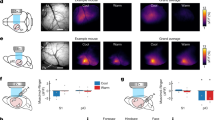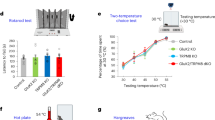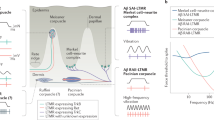Abstract
We sense the temperature of our skin and surroundings using specific thermoreceptors, which are sensitive to cold and warmth1, but little is known about how these receptors transduce temperature into electrical activity. We have discovered an inward ionic current that is activated by moderate cooling in a small number of rat sensory neurons. This current has features that are found in intact cold receptors, including sensitization by menthol, adaptation upon sustained cooling, and modulation by calcium, and is likely to be important in cold sensing.
Similar content being viewed by others
Main
Cutaneous receptors are difficult to study, as they are small and inaccessible in the skin, so cultured dorsal root ganglion (DRG) neurons are widely used as a model system because they express membrane proteins that would normally be present at their receptor termini. We found previously that very few DRG neurons generate action potentials in response to cold2, so we measured the intracellular calcium-ion concentration by imaging3 to preselect cold-responsive rat DRG neurons after 2–4 days in primary culture, applying thermal stimuli with a Peltier-based device4 from a base temperature of 32 °C. Of 643 DRG neurons, 45 (7%) responded to cooling to 20 °C by increasing their intracellular Ca2+ concentrations. This is consistent with the proportion of cold thermoreceptor afferents in the rat hindlimb5,6.
In the cold-responsive DRG neurons, we measured membrane potential and ionic currents using perforated-patch recording. We raised the temperature (for about 10 s) from 32 °C to 37 °C, and then applied a ramp from 37 °C to 18–20 °C over a 30-s period. From a resting potential of −53.3 ± 7.9 mV (s.d.; n = 32), the cooling ramp induced a depolarization of 7–49 mV (22.3 ± 11.2 mV) and high-frequency action potentials (Fig. 1a). Cooling at −80 mV elicited an inward current (Fig. 1b) with a threshold of 23–34 °C (28.7 ± 2.7 °C; n = 27) and a maximum amplitude of 40–350 pA.
a, Top, depolarization and action potentials during cooling in a rat dorsal root ganglion neuron; middle, sensitization by 10 μM (−)menthol in the same neuron (10 μM bupivacaine was added to reduce action-potential frequency); bottom, thermal stimulus. b, Current–temperature relationship of cold-induced current during ramps similar to those in a, and the sensitization induced by 10 μM and 100 μM (−)menthol. c, Adaptation of the cold-induced current during prolonged cooling to 15 °C (horizontal bars) and recovery at 32 °C; action potentials in cell processes are apparent.
This current was present in all cold-responsive neurons tested, and was absent from all of 16 unresponsive ones, showing that it is not a ubiquitous current in primary somatosensory neurons. By applying temperature steps, we found that the activation and deactivation of this current were as rapid as (and perhaps limited by) the time course of the thermal stimulus, which has a time constant of about 5 s (ref. 4). During sustained cold stimulation, the current adapted almost completely, with a time constant of 62–69 s (n = 4; Fig. 1), consistent with the slow adaptation of cold receptors in vivo7.
The cold-receptor stimulant (−)menthol8,9 substantially increased the amplitude of the cold-induced current and shifted its activation threshold towards higher temperatures, by 4.2 ± 2.0 °C at 10 μM (n = 16) and by 7.6 ± 2.6 °C at 100 μM (n = 9; Fig. 1b). A low extracellular Ca2+ concentration potentiated the current (1.5–2.8-fold at 0.1 mM; n = 6), whereas increasing the extracellular Ca2+ concentration to 10 mM reduced it slightly and reversed the sensitization induced by 10 μM menthol (n = 4); intact cold receptors are similarly affected by changes in Ca2+ concentration9,10. All of the effects due to menthol and altered Ca2+ were reversible.
The reversal potential of the cold- and menthol-induced current obtained by subtraction during voltage ramps was + 13.3 ± 5.2 mV (n = 6), indicating that it is probably a mixed-cation current. We cannot assign it to one of the known families of cation channels involved in somatosensory transduction, as amiloride (100 μM), which blocks acid-sensitive and mechanosensitive channels of the degenerin family, had no effect (n = 6), whereas ruthenium red (10 μM), a blocker of the heat-sensitive VR-1 and VRL-1 channels, reversibly increased the current (n = 6).
Our observations suggest that the mode of action of menthol on cold receptors should be reconsidered. An early model indicated that menthol stimulates cold receptors by blocking voltage-dependent Ca2+ channels, leading to a reduction in intracellular Ca2+ and inhibition of Ca2+-dependent K+ channels9. However, we and others11 have since discovered that menthol stimulates entry of Ca2+ and increases intracellular Ca2+ concentration in cold-sensitive neurons; the stimulation of cold receptors by menthol can be explained more simply by sensitization of the cold-induced inward Ca2+ current.
To our knowledge, this is the first description of an ionic current that is activated by cooling. The properties of this current can account for several features of cold-receptor function: it is activated over the temperature range in which mammalian cold receptors are most sensitive1; its rate of adaptation is similar to that observed in vivo7; and its potentiation by menthol and modulation by calcium are similar to the response of intact cold receptors8,9,10. We propose that this cold-activated current is the principal determinant of cold-receptor activity, and that inhibition of a background K+ current2 and of the electrogenic Na+/K+-ATPase12 are of secondary importance.
References
Hensel, H. Thermoreception and Temperature Regulation (Academic, London, 1981).
Reid, G. & Flonta, M.-L. Neurosci. Lett. 297, 171–174 (2001).
Suto, K. & Gotoh, H. Neuroscience 92, 1131–1135 (1999).
Reid, G., Amuzescu, B., Zech, E. & Flonta, M.-L. J. Neurosci. Methods 111, 1–8 (2001).
Gee, M. D., Lynn, B., Basile, S., Pierau, F. K. & Cotsell, B. Neuroscience 90, 509–518 (1999).
Leem, J. W., Willis, W. D. & Chung, J. M. J. Neurophysiol. 69, 1684–1699 (1993).
Kenshalo, D. R. & Duclaux, R. J. Neurophysiol. 40, 319–332 (1977).
Hensel, H. & Zotterman, Y. Acta Physiol. Scand. 24, 27–34 (1951).
Schäfer, K., Braun, H. & Isenberg, C. J. Gen. Physiol. 88, 757–776 (1986).
Hensel, H. & Schäfer, K. Pflügers Arch. 352, 87–90 (1974).
Okazawa, M., Terauchi, T., Shiraki, T., Matsumura, K. & Kobayashi, S. NeuroReport 11, 2151–2155 (2000).
Pierau, F., Torrey, P. & Carpenter, D. Brain Res. 73, 156–160 (1974).
Author information
Authors and Affiliations
Corresponding author
Rights and permissions
About this article
Cite this article
Reid, G., Flonta, ML. Cold current in thermoreceptive neurons. Nature 413, 480 (2001). https://doi.org/10.1038/35097164
Issue Date:
DOI: https://doi.org/10.1038/35097164
This article is cited by
-
Mammalian cold TRP channels: impact on thermoregulation and energy homeostasis
Pflügers Archiv - European Journal of Physiology (2018)
-
Enhancing effect of menthol on nicotine self-administration in rats
Psychopharmacology (2016)
-
AMG2850, a potent and selective TRPM8 antagonist, is not effective in rat models of inflammatory mechanical hypersensitivity and neuropathic tactile allodynia
Naunyn-Schmiedeberg's Archives of Pharmacology (2015)
-
What Causes Eye Pain?
Current Ophthalmology Reports (2015)
-
Effects of Activation of TRPM8 Ion Channels on Thermoregulatory Reactions in Cooling
Neuroscience and Behavioral Physiology (2012)
Comments
By submitting a comment you agree to abide by our Terms and Community Guidelines. If you find something abusive or that does not comply with our terms or guidelines please flag it as inappropriate.




